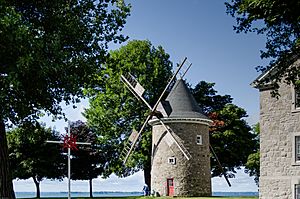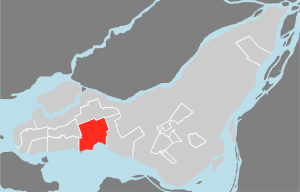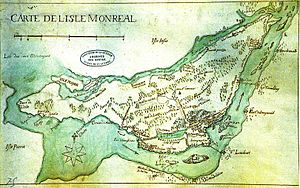Pointe-Claire facts for kids
Quick facts for kids
Pointe-Claire
|
|
|---|---|
|
City
|
|

|
|

Location of Pointe-Claire on Montreal Island
|
|
| Country | Canada |
| Province | Quebec |
| Region | Montréal |
| RCM | None |
| Settled | 1698 |
| Village | September 2, 1854 |
| Ville | March 3, 1911 |
| Merged | January 1, 2002 |
| Reconstituted | January 1, 2006 |
| Named for | Point of land with a clear view over Lake Saint-Louis |
| Area | |
| • Total | 34.66 km2 (13.38 sq mi) |
| • Land | 18.91 km2 (7.30 sq mi) |
| Population
(2021)
|
|
| • Total | 33,488 |
| • Density | 1,770.9/km2 (4,587/sq mi) |
| • Pop 2016-2021 | |
| • Dwellings | 13,823 |
| Time zone | UTC−5 (EST) |
| • Summer (DST) | UTC−4 (EDT) |
| Postal code(s) |
H9R, H9S
|
| Area code(s) | 514 and 438 |
| Highways |
|
Pointe-Claire is a city in Quebec, Canada. It is located on the Island of Montreal and is part of the larger Urban agglomeration of Montreal. The city is fully developed with homes, factories, and shops. In 2021, about 33,488 people lived there.
What's in a Name?
The name Pointe-Claire (pronounced Pwant-Clair) comes from a special piece of land. This land, or "point," sticks out into Lac Saint-Louis. From this point, you can see clearly all around, which is how it got its name. A windmill, a convent, and the Saint-Joachim de Pointe-Claire Church are all located on this point.
A Look Back in Time
The area of Pointe-Claire was first mentioned in 1669 by a person named Nicolas Perrot. The name "Pointe-Claire" even appeared on a map as early as 1686. Before that, in 1613, Samuel de Champlain traveled through the area by canoe. However, he didn't see any villages or homes.
Early Settlement and Land Grants
The development of Pointe-Claire began in the 1600s. At that time, a group called the Sulpicians owned the Island of Montreal. They started giving out pieces of land, called "concessions," along the main waterways.
In 1678, the first land grant in the area was given to Jean Guenet. He named his property "Beau Repaire." This was part of the old seigneurial system, where lords granted land to settlers. The first land grant within today's Pointe-Claire city limits happened in 1684. It went to Pierre Cabassier. The Sulpicians, as lords, had to build a mill for the colonists to grind their grain. French settlers started arriving in Pointe-Claire around 1698-1699.
Roads, Churches, and Growth
After a peace treaty was signed in 1701, a road called the Chemin du Roy (now Lakeshore Road) was opened in 1707. This road connected Dorval to the western tip of Montreal Island. Before this road, Pointe-Claire could only be reached by boat.
In 1713, a church parish was formed, covering Pointe-Claire and much of the West Island. A church was built in 1714 at the point. It was first called Saint-Francois-de-Sales, but soon changed to Saint-Joachim de la Pointe Claire. The church and its nearby building were made of stone and formed a small fort. This was done because people were worried about attacks from the Iroquois. The point also became a stopping place for travelers heading further inland.
By 1765, Pointe-Claire had 783 residents and 19 houses. Many of these houses were made of wood, but some were stone.
Becoming a Village and City
Pointe-Claire officially became the Village Municipality of Saint-Joachim-de-la-Pointe-Claire on July 1, 1845. It lost this status for a short time but got it back on September 2, 1854.
The Grand Trunk Railway built a railroad through the area in 1855. This connected Pointe-Claire to Montreal. The railroad brought more people and led to new homes being built. It also helped farmers sell their goods more easily. In 1893, suburban development really began when Otto Frederick Lilly bought land and convinced the Canadian Pacific Railway to add a train station.
In 1900, a big fire destroyed many buildings in the village, including the post office and town hall. About 30 buildings were lost, leaving 200 people without homes. On March 14, 1911, the village officially became the Ville (city or town) de Pointe-Claire.
Modern Changes
In 1940, a new highway, now called Quebec Autoroute 20, was built next to the railway. This caused many town buildings, like the town hall and police station, to move from the south side of the highway to the north.
From 2002 to 2006, there were big changes to cities in Quebec. Pointe-Claire was briefly merged into Montreal and became a borough. However, after some political changes, it became an independent city again in 2006.
Exploring Pointe-Claire's Geography
Pointe-Claire is located along the shore of Lake Saint-Louis. The land near the lake is about 30 meters (98 feet) above sea level. It then rises about another 30 meters (98 feet) further inland. The eastern part of the city has clay-rich soil, while the western part is stonier with limestone.
Pointe-Claire is surrounded by other cities: Dollard-des-Ormeaux to the north, Dorval to the east, Lac Saint-Louis to the south, and Kirkland and Beaconsfield to the west.
The city is fully developed, but it still has many green spaces. There are 38 public parks with baseball fields, playgrounds, soccer pitches, swimming pools, tennis courts, and skating rinks.
Green Spaces and Parks
- The Terra-Cotta Natural Park is a large natural green space, covering 39 hectares (96 acres). It has six kilometers (4 miles) of paths for walking and exploring. Long ago, from 1912 to 1962, clay was dug up here to make hollow tiles for building.
- The Last Post Fund National Field of Honour is a special place that is open to the public. It is a National Historic Site of Canada.
- The Beaconsfield Golf Course is a private golf course. It is built on the site of an old quarry that provided limestone for building the Victoria Bridge in 1860.
Who Lives in Pointe-Claire?
|
||||||||||||||||||||||||||||||||||||||||||||||||||||||||||||||||||||||||||||||
Pointe-Claire is officially a bilingual municipality since 2005. This means both English and French are used in city services.
In 2021, the city had a population of 33,488 people. This was a 6.7% increase from 2016. The city is quite dense, with about 1,770 people living in each square kilometer.
| Canada census – Pointe-Claire community profile | |||
|---|---|---|---|
| 2016 | |||
| Population: | 31,380 (+1.9% from 2011) | ||
| Land area: | 18.90 km2 (7.30 sq mi) | ||
| Population density: | 1,660.0/km2 (4,299/sq mi) | ||
| Median age: | 47.6 (M: 45.1, F: 49.6) | ||
| Total private dwellings: | 12,835 | ||
| Median household income: | $80,242 | ||
| References: 2016 earlier | |||
Languages Spoken at Home (2021)
| Language | Population | Percentage (%) |
|---|---|---|
| English | 20,705 | 63% |
| French | 5,485 | 17% |
| Other | 4,660 | 14% |
Mother Tongue (2021)
| Language | Population | Percentage (%) |
|---|---|---|
| English | 15,595 | 47% |
| French | 6,750 | 21% |
| Other | 8,565 | 26% |
Diversity in Pointe-Claire (2021)
| Ethnicity | Population | Percentage (%) |
|---|---|---|
| Not a visible minority | 23,545 | 75% |
| Visible minorities | 8,015 | 25% |
Economy and Jobs
Pointe-Claire has a big area for businesses and factories, located on both sides of Quebec Autoroute 40. The manufacturing sector, which involves making things, provides the most jobs in the city. About 23.7% of all jobs are in manufacturing. However, jobs in this area have been decreasing, while jobs in healthcare and social services are growing.
Retail, which means selling goods in stores, is the second largest job sector. Big companies that employ many people (more than 500) include Future Electronics, Lakeshore General Hospital, Avon, and the City of Pointe-Claire itself. Some companies that have their main offices in Pointe-Claire are Bouclair, Novacam Technologies, and The Canadian Salt Company Limited.
City Services and Facilities
Pointe-Claire offers many sports and leisure facilities for its residents. These include an Aquatic Centre for swimming, the Bob Birnie Arena for skating, and the Pointe-Claire Public Library. There's also the Stewart Hall Cultural Centre for arts and culture, and a Sailing Base at Grande-Anse Park. The city also has a water treatment plant that provides clean drinking water to Pointe-Claire and several nearby cities.
Getting Around Pointe-Claire
Two major highways, Quebec Autoroute 20 and Quebec Autoroute 40, run through Pointe-Claire from east to west. These highways have exits at Boulevard Saint-Jean and Boulevard Des Sources, which are the main roads going north and south.
Pointe-Claire also has three train stations on Exo's Vaudreuil–Hudson line: Pointe-Claire station, Valois station, and Cedar Park station. The city is also served by several bus routes run by Société de transport de Montréal (STM), with a main bus terminal at Fairview Pointe-Claire.
Starting in 2024, Pointe-Claire will have two new rapid transit stations as part of the Réseau express métropolitain (REM) network: Fairview–Pointe-Claire station and Des Sources station.
Schools in Pointe-Claire
Pointe-Claire has both English and French public schools.
English Schools
The Lester B. Pearson School Board (LBPSB) runs the English public schools.
- Elementary Schools: Clearpoint (formerly Cedar Park) and St. John Fisher.
- High Schools: John Rennie and St. Thomas.
St. Thomas High School moved into the building that used to be Lindsay Place High School.
French Schools
The Centre de services scolaire Marguerite-Bourgeoys operates the French public schools.
- Elementary Schools: Marguerite-Bourgeoys, Pointe-Claire (formerly Lakeside Heights Elementary), and Saint-Louis.
- High School: The École secondaire Felix-Leclerc (formerly École secondaire Saint-Thomas).
See also
 In Spanish: Pointe-Claire para niños
In Spanish: Pointe-Claire para niños





